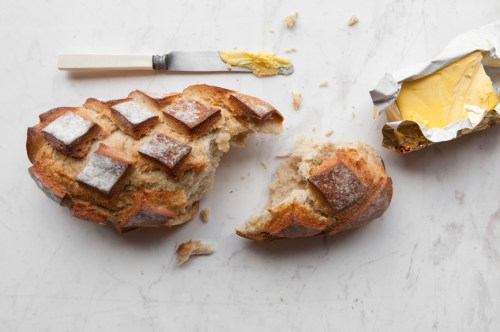‘I’m a Gastroenterologist, and This Is the Simple Sourdough Bread I Eat Every Day for Gut Health and Regularity’
Learn why a gastroenterologist deems sourdough the best bread for gut health and how to make it from scratch with only two ingredients.

Dan Buettner, a National Geographic reporter, longevity expert, and founder of the Blue Zones, has plenty of research to show that bread is a staple food for many of the longest-living people on the planet—sourdough bread in particular.
Experts in This Article
South Carolina-based gastroenterologist and author of Fiber Fueled
This is why we weren’t the slightest bit surprised to hear that sourdough bread also happens to be a gastroenterologist’s number one bread option for gut health. After all, sourdough contains natural probiotics (aka good gut bacteria) due to fermentation. Find out how eating sourdough bread benefits your microbiome and why a gut health specialist would choose this type of bread over all of the other kinds any day. Plus, a gastro-approved sourdough starter recipe to get baking ASAP.
Why a gastroenterologist deems sourdough the top type of bread for gut health
According to a recent TikTok video by Will Bulsiewicz, MD, a gastroenterologist and New York Times bestselling author of The Fiber Fueled Cookbook, sourdough isn’t like your run-of-the-mill bread in a bag. That’s because it’s made up of living organisms that support a healthy gut. “My favorite bread for digestion and gut health is sourdough bread. Sourdough is incredible because these microbes [yeasts and lactic acid bacteria] are transforming the flour. They’re slowly fermenting it, releasing vitamins, additional nutrients, and new forms of fiber, believe it or not,” Dr. Bulsiewicz says.
But how is this possible? Time for a bit of science. During the process of making a sourdough starter, lactic acid bacteria and yeast are released when the flour and water are combined and fermented over the course of a few days. As yeast is activated in the sourdough starter, it feeds on the sugars in the flour and releases carbon dioxide gas that makes the dough rise. Meanwhile, the lactic acid bacteria produce lactic acid, which is what gives sourdough its signature sour-ish flavor.
The interaction between these elements gives sourdough bread its gut-friendly properties. “Thanks to the process of fermentation required for making starter, sourdough bread tends to have more prebiotic properties and also may enhance nutrient absorption compared to other forms of bread, especially those made without whole grains,” registered dietitian Kelly Jones, MS, RD previously shared with Well+Good.
In addition to prebiotics, Dr. Bulsiewicz says sourdough bread can be helpful for those with digestion concerns. “The other thing [microbes in sourdough] are doing is reducing some of the things that can cause trouble for people with digestive. There’s less gluten and fructans in sourdough. So what that means is that if you have food intolerances and you struggle to eat regular bread, you need to be trying sourdough because this may work for you,” he says. Time to get baking, am I right?
Thankfully, Dr. Bulsiewicz also shared his go-to sourdough starter recipe. Plus, you can find 15 pages dedicated to this type of bread and five additional sourdough recipes in his book, The Fiber Fueled Cookbook.
A gastroenterologist’s sourdough starter recipe
Yields 1 sourdough starter
Ingredients780 grams flourWater, chlorine-free
Day 1: In a small bowl or jar with tall sides, mix 60 grams (1/2 cup) of any type of flour (or a 50/50 mix) along with 60 grams (1/4 cup) of room-temperature water. Stir well. Stirring helps to disrupt microbial activity and aerate the mixture, contributing to rapid yeast growth. The consistency should be thick and pasty. You can add a bit more water if needed to thin out the texture. Cover with a piece of cheesecloth or kitchen towel and set in a warm space (ideally between 75 and 80°F).
Day 2: Leave your starter alone and let it rest. You may see bubbles, which are signs of microbial activity.
Day 3: Using a wooden spoon, remove and discard about half of your starter from your jar. Add 60 grams (1/2 cup) of flour and 60 grams (1/4 cup) of tepid water in a 1:1 ratio, then mix it until smooth. The texture should resemble thick pancake batter. Cover the jar and leave it until the next feed the following day.
Day 4 and onward: Repeat the same process as outlined on day three. As the yeast develops, your starter will rise, and bubbles will form throughout the culture. When the starter falls, it’s time to feed it again. You can experiment with feeding once or twice per day; either can work.
When is your starter ready? When it’s at its peak ripeness, it will be bubbly and double in size by eight hours after feeding. It will smell yeasty and appear stringlike or weblike. You will also hear bubbles popping when you stir. At this point, it’s ready to be used. Transfer it to a clean jar and give it a name.
An RD shares a guide to gut health:
Sign Up for Our Daily Newsletter
Get all the latest in wellness, trends, food, fitness, beauty, and more delivered right to your inbox.
Got it, you've been added to our email list.










